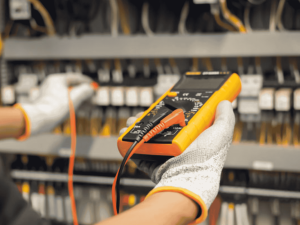In any workplace, safety should always come first. While most businesses are diligent about fire safety, manual handling, and chemical hazards, one area often overlooked is electrical safety. Faulty appliances, worn-out cords, or out-dated electrical systems can pose serious risks—leading to fire, injury or even fatal accidents.
Regular testing and tagging of electrical equipment play a vital role in maintaining a safe environment. Whether you’re operating in an office, workshop, warehouse, or hospitality venue, being proactive with electrical safety can prevent disasters before they happen. At the heart of this process is fire protection, and electrical compliance is an essential component of it.
Understanding Electrical Hazards in the Workplace
Electrical hazards don’t always come with visible signs. A machine may work perfectly fine on the surface while harbouring worn cables, loose connections, or internal faults. These hidden dangers can cause:
- Electric shocks
- Equipment failure
- Fires due to overheating
- Downtime and costly repairs
- Workplace injuries and legal liabilities
Identifying and eliminating these risks early through structured inspection and maintenance is key to a safe, compliant workplace.
What is Electrical Testing and Tagging?
Electrical test and tag in Melbourne is a safety procedure that involves inspecting and testing all portable electrical appliances in the workplace. It ensures they meet national safety standards (AS/NZS 3760:2022) and are safe to use.
The process includes:
- Visual inspection to check for wear, damage, and loose parts
- Electrical testing using a Portable Appliance Tester (PAT)
- Tagging with a label that displays the test date, next due date, and technician’s details
Once completed, each item is certified as safe or marked for repair or replacement. This provides a clear, trackable safety record.
Why Regular Testing Matters More Than You Think
While an appliance may look and feel safe, issues often go undetected without proper equipment. Routine test and tag in Melbourne allows businesses to:
- Reduce the risk of electrical fires
- Minimise employee exposure to faulty equipment
- Stay compliant with OH&S and Work Safe regulations
- Avoid insurance complications in the event of an incident
- Build a culture of safety in the workplace
Many insurance providers now require evidence of regular electrical testing as part of their fire and safety policies. Skipping it could invalidate your coverage.
Frequency of Testing: How Often Should It Be Done?
The frequency of testing and tagging depends on the environment and level of risk. Here’s a general guideline based on Australian safety standards:
- Construction, mining, demolition – every 3 months
- Factories and warehouses – every 6 months
- Offices, retail, classrooms – every 12 months
- Low-risk residential settings – every 2 years
High-traffic and high-use environments may require more frequent checks. A qualified technician can help assess your workplace and set up an appropriate schedule.
Common Issues Found During Test and Tag
When performing electrical test and tag in Melbourne, there are several common issues that technicians frequently encounter:
- Damaged power cords or plugs – frayed or exposed wires are a serious hazard.
- Overloaded power boards – can cause overheating and fire.
- Incorrect fuse ratings or modified plugs – can lead to system failure.
- Appliances without grounding (earthing) – higher shock risk.
- Out-of-date testing records – non-compliance and missed defects.
Finding these issues early allows for fast action before they turn into bigger problems.
Best Practices for a Safer Workplace
Following a few key practices can dramatically reduce the risk of electrical hazards:
- Create an appliance register to track testing schedules
- Label all tested items clearly with pass/fail status and next due date
- Immediately remove unsafe appliances from use
- Train employees to spot and report signs of wear or fault
- Engage certified professionals for all testing, tagging, and repairs
- Schedule testing during off-peak hours to reduce downtime
A proactive approach to safety doesn’t just protect your team—it also boosts productivity and peace of mind.
Who Should Perform the Test and Tag?
Testing and tagging must be carried out by someone deemed a “competent person” as defined by Australian standards. This usually means a licensed electrician or a certified technician who has completed a recognised training course.
DIY or in-house testing without proper training can lead to incomplete inspections, overlooked hazards, and non-compliance. That’s why businesses trust professionals to carry out test and tag in Melbourne services thoroughly and reliably.
Integrating Electrical Testing into Your Fire Safety Plan
Many fires in commercial settings start with electrical faults—overloaded circuits, damaged cords, or faulty appliances. Ensuring your electrical systems are in top condition is not just about preventing shocks; it’s about fire prevention too.
As part of your broader fire protection strategy, regular test and tag procedures complement other safety measures such as:
- Fire extinguisher inspections
- Smoke alarm testing
- Emergency lighting maintenance
- Evacuation planning
Together, these measures form a comprehensive defence against workplace hazards.
Stay Safe. Stay Compliant. Stay Switched On
Electrical hazards may be silent, but the damage they cause can be devastating. Through regular inspection, testing, and proactive maintenance, businesses can protect their people, property, and operations from unexpected threats.
Don’t wait for a fault to reveal itself when it’s too late.
Why worry when you have the experts to take care of it? Partner with Australia Fire Protection for professional, reliable Electrical Test and Tag services. Our experienced team helps you stay compliant, minimise risks, and create a safer workplace.
Call 1300 475 715 today to schedule your next test and tag service or request a full fire safety audit.



